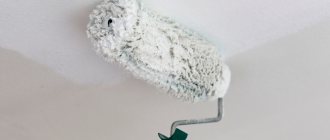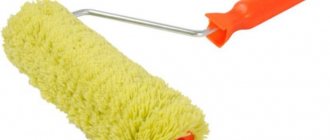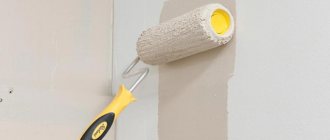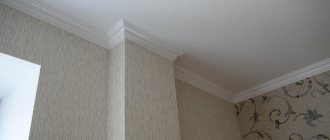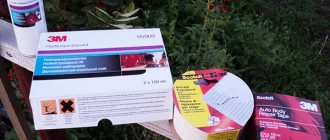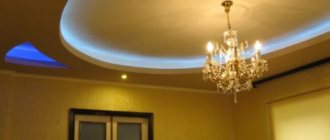Reason #3: Incorrectly selected tool
Before you start painting surfaces, you should carefully select a quality tool.
Namely:
- 2 rollers;
- thin and wide brush.
With the help of rollers you will paint the entire surface, and with a brush you can get into hard-to-reach places - in the corners.
The roller evenly paints the ceiling and walls; if the tool is dirty, cracks will appear on the surface or the paint will lie unevenly.
Important! You need to choose a roller with a long pile - 1 cm. This way, you can get a lot of paint and it’s easier to get uniform coloring. To re-paint, you need to choose a tool with short pile -5-6 mm; it will not leave smudges and will save you material.
A brush should be chosen with natural bristles so that it does not leave lint on the surface.
Painting the ceiling over old paint with water-based paint
How to paint a ceiling using old paint
If the owner is faced with the task of updating an already painted surface, that means applying another layer of paint to it. How to do this so that the work does not turn out to be useless?
To paint the ceiling over old paint without any problems, you need to consider some points.
To avoid unpleasant situations when painting, you need to prepare the surface well. You cannot hope that by covering the ceiling with new paint you can hide all the defects. Everything is completely the opposite, a layer of paint will highlight everything: scratches, waves after painting, unevenness. First, it is important to carefully inspect the ceiling. If everything is fine, you need to start priming. But if there is paint on the surface that has peeled off or does not adhere well to the base, then all such paint must be removed. This can be done using sandpaper. After this, treat the surface with a thin layer of primer. After the primer has dried, we begin to renew the surface. If we see that the surface needs trimming, then we need to putty or even plaster the surface being treated. If this needs to be done, then priming must be carried out more intensively. You can even do this in several layers. This will ensure quality of work. It is best to apply the primer with a brush rather than a roller. This will ensure good penetration of the primer into uneven areas and depressions.
But if there is no paint on the ceiling, but old whitewash, then simply cleaning the surface and priming will not do. The entire applied layer of white must be completely removed.
After the surface is completely prepared for painting, you need to cover the walls and floor with film so that they remain clean. The temperature in the room when painting must comply with the instructions. Also, in order to paint the ceiling over old paint, you need to prepare the tool and the paint you have chosen. Both paint and tools must be of good quality. Because the final result of the work done depends on it. Rollers and brushes will be needed in various sizes, and you can also purchase a telescopic extension and a paint cuvette for convenience.
How to paint a ceiling using old paint using technology so that there are no unpleasant moments later?
The first thing to do is paint the corners of the ceiling. This can be done with a small brush or roller. Walk with these tools along the entire perimeter, in a strip of 5 centimeters. And the entire surface of the ceiling is then painted with a large roller. For high-quality painting you need to apply at least two layers. The first layer should be applied starting from the window, across the daylight. Pour a small amount of paint into the cuvette, immerse the roller in the paint, and then carefully roll it out on a special platform. This will remove all the excess paint, which will help distribute it evenly across the ceiling. There is no need to make sudden movements, smoothly move the roller along the ceiling, at the same time inspecting for the presence of unpainted areas. And if any are found, paint them over immediately. To paint the ceiling with a second layer of old paint, you need the same technology. The second layer is applied after careful checking to ensure that the first coating is of high quality and that it has completely dried. After painting the second layer, you need to make sure that direct ultraviolet rays do not reach the ceiling and that there are no drafts. Never try to speed up the drying of paint in any way, let it happen naturally. This way you can avoid the paint peeling off from the base. After each painting, ensure that the tool remains clean and free of paint residue.
What defects can occur when painting the ceiling?
Roller streaks may appear. They are formed when the roller is rolled out poorly. You can avoid this by re-rolling the roller over the painted base when there is no paint on the roller. This can also happen if the roller is not loaded correctly when painting. It is important to distribute the force applied to the tool so that the load is even.
It is also important that before you start working, you need to mix the paint well so that there are no stripes that will differ in shade.
If you follow the painting technology, there will never be a reason to look for flaws in the work done. And the result will pleasantly surprise you.
How to paint a ceiling with water-based paint over old paint
In order to paint the ceiling with water-based paint, you need to know how to do it correctly. The effectiveness of the result depends not only on how much the emulsion used costs and what quality it is. It is also important to follow all technological rules.
Is it possible to paint a ceiling using old paint? The answer to this question can be either positive or negative. The fact is that painting over the old layer is permissible only if its condition meets the requirements of the prepared surface:
- There should be no cracks or unevenness on the ceiling.
- The paint must adhere firmly to the surface.
- The old layer has a small thickness.
- dye;
- roller;
- small brush or roller;
- putty knife;
- water container.
If you notice areas of cracked or fallen paint on the ceiling, then you need to completely eliminate these imperfections and achieve a smooth, even surface. Otherwise, if there are too many imperfections on the previous layer of paint, you will need to completely remove it. This process is quite labor-intensive and complex. It should also be taken into account that it will not be possible to quickly remove the old layer. Therefore, at first you should try to correct only the problem areas. The same applies to situations where whitewashing was done as a previous finish.
Preparing for coloring
In order to begin work on preparing the surface and working with water-based paint, you will need the following tools:
A spatula should be used to level the surface. Using this tool, you can also scrape off the layer of old paint in those places where it comes away from the base. All existing cracks must be repaired with putty, after slightly widening them. Regardless of which surface the layers of emulsion will be applied to, it is important to achieve an absolutely smooth structure, free from any irregularities or other flaws. You should also remove all furniture from the room or cover it with film. When all these steps have been completed, you can begin applying the emulsion.
After the ceiling is leveled and prepared, you need to apply water-based paint. To achieve the required consistency, the emulsion is diluted with water in the ratio: ten parts of water-emulsion substance, one part of water. It is important to thoroughly stir the substance before starting work.
You need to start painting water-based paint from the corners. To do this, you need to take a brush and carefully, without getting on the walls, paint the corners. Next, with the same brush you need to go over the entire perimeter of the ceiling. This is necessary so that when working with a large roller you do not get it on the ceiling plinth or wall. The width of the strip should be 4 or 6 centimeters. Then you need to take a roller and paint the entire ceiling. It is not recommended to make sudden movements; the roller should be rolled as carefully and smoothly as possible.
When working with water-based paint, it is very important not to apply a large amount of emulsion to the ceiling at once. The surface must be painted in stripes. After every three or four stripes, the roller should be lowered into the container with the emulsion again. In order for the substance to apply evenly, you need to roll it several times with a roller on a clean surface (there are special painting trays on sale for this). This is the only way to get a streak-free ceiling after the work is completed.
How to achieve better results
It is important to let the water-based paint dry after each coat. This requires at least four hours, depending on the type of emulsion. During work, you should periodically move away to different distances to see in which places the substance has not been applied enough.
In order for the ceiling to maintain its attractive appearance for a long time, it is necessary to protect it from sunlight for the first time after painting. You should also avoid drafts in the room. This will not speed up drying, but will only destroy the structure of the emulsion.
To prevent the formation of marks from the roller in the form of stripes, you need to do several rolls on the ceiling during work after the paint on the roller has run out. It is also important to control the load on the tool. The pressure on all sides of the roller should be equal. If dents are found during painting, then it will not be possible to remove this effect with water-based paint. In this case, you will have to remove all the old layers and re-plaster the ceiling. If you find traces from the roller in the form of stripes of different colors, you need to thoroughly mix the paint again and, changing the angle of view, check whether any areas are missing.
The result is largely determined by the quality of the materials used. When choosing water-based paint, you need to carefully study the label. You should select an emulsion specifically for ceilings, and also pay attention to the characteristics of the substance, such as composition and level of wear resistance.
Reason #5: Applying paint in one layer
If you apply paint only once, it may peel and crack after drying, so the material should be applied in 2-3 layers.
If the paint runs out, it will be very difficult in the store to choose the right shade so that the wall does not end up being painted in two different shades, for example, soft yellow and dark yellow.
The surface will be covered in stains, and the appearance will leave much to be desired. Especially if it is water-based paint, you should immediately calculate the paint.
Now you know how to avoid many problems with painting surfaces, so that the paint does not peel or crack.
